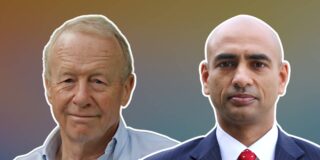When you think of the United Arab Emirates (UAE) today, you may imagine the world’s tallest skyscrapers, metropolitan cities bustling with 203 nationalities and fast-moving business. This present-day reality is made even more extraordinary in context.
In 1959 in Al Ain, a district of Abu Dhabi, the capital of the UAE—at the time, the United Arab Emirates had not united yet, and it was still called the Trucial States—the population was in crisis. One in every two children and one in every three mothers were dying in childbirth. Formal health care was virtually nonexistent and traditional practices were common. One such practice was wasim, or the practice of heating metal and applying it to parts of the ailing body to seal or disinfect wounds.
History of the United Arab Emirates
Sheikh Zayed bin Sultan al-Nahyan and his brother Sheikh Shakhbut had visited Christian mission hospitals in Oman and Bahrain prior, and invited Pat and Marian Kennedy, Christian missionary general practitioners living in Jordan, to come to Al Ain to set up the first maternity hospital. The Arabic-fluent doctor couple arrived in Al Ain in November 1960 with their four young children. The hospital was called Oasis Hospital and reflected the humbleness of the time, built from mud brick and barasti palm fronds.
“We loved it right away,” remembers Kathleen Kennedy, the eldest Kennedy daughter. “[Emiratis] were so welcoming. The people were always so generous. We were taught quickly, if you liked something, do not compliment anybody because they would take it off and give it to you.”
“We used to swim as kids in the falajs (these clear water wells underground connected by these tunnels, often with small fish) and play out—unsupervised—in the sands,” smiles her younger sister, Nancy Kennedy.
Al Ain at the time had no formal banks, no electricity or plumbing—even ice was a foreign concept.
“When we first got there, they did not know what ice was,” recalls Kathleen. “We said ‘it’s hard, cold water’ [and] they said ‘how can water be hard?’ And so it’s so ironic, within five years if you handed them a glass without ice in it, they’d say ‘where’s the ice?’” And the speed at which the UAE grew extended to all aspects—technology as well as population.
Childbirth Mortality
The Kennedy doctors, very quickly upon arrival, learned of the reason for high mortality rates amongst newborns and mothers. A standard practice at the time was using salt as a disinfectant. Prior to 1960, when a woman would give birth, her first delivery was the easiest. Afterward, out of fear of infection, those helping the mother would pack rock salt the size of an egg between her legs. Salt caused the skin to scar down, “and scar tissue doesn’t tear—it rips,” explains Kathleen.
“My mother didn’t know about this ahead of time. She discovered later [that women] were not dilating … They would die in childbirth, there was a 50% mortality rate.”
Without many resources, Marian devised an uncommon solution: During childbirth, she would cut the cervix of the mother a little bit at a time to help the mother dilate. Because the baby’s head would press against the skin, the mother wouldn’t bleed out. After the baby was safely delivered, instead of the traditional rock salt practice, Marian would give the patients antibiotic shots to prevent infection. As more mothers gave birth successfully and the mortality rate declined amongst newborns and mothers, word spread quickly. Women came from all over the area, even Oman, to deliver at Oasis Hospital.
“I do some English teaching,” says Fiona Duerden, who helped with the PR and communications for the present-day Oasis Hospital. “And I was chatting with a group of women students. They were talking about birth, and how difficult birth can be. And this one student said to me, I once said to my mother, ‘How did girls do it before there was AC, before there were hospitals?’ and my mother said, ‘They didn’t, lots of them died.’ And she said, you know, I started to cry for my history and my heritage and my community that it was so hard that so many people died. And then she looked at me and said, ‘And that is why I love Oasis because when Oasis came, people stopped dying.’ That’s the difference they made. And that’s why I have all of my children at Oasis.”
The Kennedys worked at Oasis Hospital for 15 years, returning home to the United States perhaps three times only during those years. They were extremely devoted to the patients and the community, and until this day are fondly remembered. Today, Oasis Hospital is sometimes confused as a Canadian hospital because Emiratis often refer to the hospital as the “Kanady Hospital.”
*[This feature was originally published by Kerning Cultures, a partner institution of Fair Observer.]
The views expressed in this article are the author’s own and do not necessarily reflect Fair Observer’s editorial policy.













